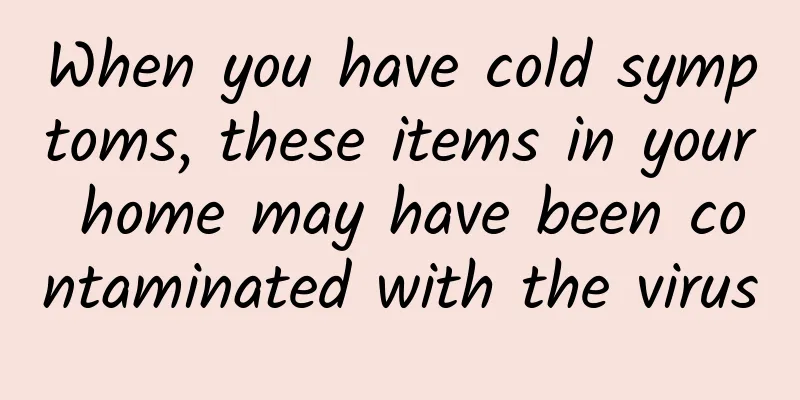When you have cold symptoms, these items in your home may have been contaminated with the virus

|
Recently, the COVID-19 outbreak has spread across the country. The World Health Organization released a briefing on Omicron on December 23, 2021, showing that its family secondary infection rate (i.e., second-generation incidence rate) was 15.8%, higher than Delta's 10.3%. In this special period, if you have cold-like symptoms and are afraid of infecting your family, what should you do? The disease is most contagious early in its course People who work in fresh food or cold chain, receive international express deliveries, or have a history of travel or residence in areas where local cases continue to spread, should first seek medical treatment and undergo nucleic acid testing when they develop fever, cough, and other cold-like symptoms. Cold incubation period 1 day The incubation period of the common cold is about 1 day, and the onset is not acute. The main symptoms are dry, itchy or burning throat, sneezing, nasal congestion and runny nose. In the early stage of a cold, the virus is most active and there are more of them, and it is easy to sneeze. Be careful to stay away from the elderly. The incubation period of influenza is 2 to 4 days The incubation period of the flu virus is generally 1 to 7 days, and most people develop symptoms after 2 to 4 days. The flu is most infectious during the incubation period and 3 to 5 days after the onset of the disease, so try to avoid contact with family members during this period. The average incubation period of Omicron is 4.2 days The average incubation period of the Omicron variant is 3 to 4 days, with an average of 4.2 days, and it is also contagious during the incubation period. People with symptoms should undergo nucleic acid testing in a timely manner. Diseases such as the common cold, influenza, and COVID-19 are contagious from the incubation period and are most contagious in the early stages of symptoms. There are several places in the home that should be disinfected Some suspected patients with mild symptoms or asymptomatic people with a clear history of contact can self-isolate and observe to ensure the safety of themselves, their families, and friends. What to do during self-isolation? It is best for patients to live alone. If they live with others, they need to live in a well-ventilated room and reduce direct contact with other family members. Try to wear a mask, disposable gloves and protective clothing (such as plastic aprons); clean your hands before putting on gloves and after removing gloves and masks. Make sure shared areas (kitchen, bathroom, etc.) are well ventilated (keep windows open). Limit activities and minimize areas shared by those in quarantine and family members. On the basis of self-isolation, disinfect the following places every day. Air disinfection and frequent ventilation The best way is to open doors and windows for ventilation 2-3 times a day, each time for no less than 30 minutes. Families with conditions can use circulating air disinfection machines, but pay attention to use them strictly according to the instructions. Disinfecting public items with alcohol wipes Patients should also pay attention to daily disinfection of items that they frequently touch, such as light switches, door handles, faucet handles, etc., which can be wiped with 84 disinfectant or alcohol; tableware can be washed with detergent or disinfected at high temperature. Hand and skin disinfection soap and water washing Just wash your hands with hand sanitizer or soap under running water. If necessary, you can use disinfectants such as alcohol, chlorhexidine alcohol solution, and iodine tincture for disinfection. The toilet lid should be closed when flushing the toilet The new coronavirus has the potential to be transmitted through fecal-oral transmission, and there is a risk of spreading the new coronavirus through sewers and toilets. Toilets and toilets must be disinfected, and the toilet lid should be covered when flushing; for communities where sewer sealing is not strictly enforced, if reverse osmosis or water leakage is found, the sealing of toilets or urinals should be strengthened. Wash personal items separately Keep personal clothing, bed sheets, towels and other daily necessities separate from others and wash them separately. Refer to the World Health Organization's recommendations and put them in a laundry bag and wash them with clean water, or wash them in a washing machine at 60-90 degrees Celsius with ordinary household laundry detergent, and then dry them completely. There are contraindications for using disinfectants Since the outbreak of the epidemic, alcohol and 84 disinfectant have become common disinfectants in people’s homes, but improper use may bring new problems. Alcohol fire prevention Alcohol is flammable, so be careful to prevent fire when using alcohol for disinfection. Do not spray a large area of your body or object surface. After spraying alcohol locally on your body, make sure to stay away from fire or heat sources before the alcohol evaporates. Do not spray alcohol when taking buses, airplanes, high-speed trains or other means of transportation to avoid increasing the risk of accidents. Do not spray alcohol in the kitchen, especially near the stove, near gas stations, and near high-power electrical appliances such as ovens. In summer, the temperature of the car dashboard can reach over 80℃ after being exposed to the sun. It is easy to explode and burn if alcohol is added. It is best to wipe and disinfect it before getting in the car, and wait until the alcohol evaporates before getting in the car. 84 Disinfectant Avoid other cleaning agents 84 disinfectant is a chlorine-containing disinfectant, mainly suitable for scrubbing the surface of objects. The following misunderstandings should be avoided when using 84 disinfectant: Adding "84" to laundry detergent will cause a chemical reaction, weakening the effectiveness of each detergent and causing the production of chlorine gas, which will irritate the eyes, nose, throat and other organs. Mixing 84 disinfectant and toilet cleaner will also generate chlorine gas. After cleaning with toilet cleaner, be sure to wait for more than half an hour before using 84 disinfectant. If it is not diluted, it will affect the effect. 84 disinfectant should usually be diluted with water before use. The concentration of 84 disinfectant water is 300~500 mg/L. The dilution method is to find a 550 ml mineral water bottle, mix two bottle caps of 84 disinfectant with 3 bottles of clean water, and stir well. |
>>: If one day you open the door and find yourself surrounded by spiders...
Recommend
Ruofeng Popularity Leader Special Training Camp, accurately grasp the popular leader's detonation point Baidu Cloud Download
Ruofeng Popularity Leader Special Training Camp, ...
These 3 information flow cases increased my monthly salary to 30,000!
Next, let’s look at some interesting cases. Case ...
The keywords in Baidu's bidding promotion account have high display, low clicks and low consumption. What should I do? Can I delete them?
1. Positioning center. Be sure to locate the cent...
Analysis of advertising in the home furnishing industry!
As people's living standards improve, obtaini...
Why watch live broadcasts on Xiaohongshu?
Xiaohongshu needs to break out of its niche. For ...
Unexpectedly? WeChat is going to challenge the three major operators, and SIM cards may be replaced
Although WeChat is becoming more and more popular...
What should you eat and drink when you are infected with a virus and have a high fever?
With the change in epidemic policies, a large num...
I know you are hot! But I really advise you not to drink iced drinks casually! (Not because it is cold)
Recently, Mr. Wang bought a few cups of iced coff...
How to guide users to create content from 0 to 1?
1. What did Lukou Community do from 0 to 1? Lukou...
Let’s talk about how to recommend and promote good products on Zhihu in 2021!
This article mainly explains the Red Ocean strate...
7 essential promotion skills for operators! Did you know?
01 Promotion skills For operations personnel, whe...
The relationship between the three new cases, the locations involved, and the timeline are all in one picture →
Beijing Daily Client Reporter Hu Decheng Gao Shan...
Why is it difficult to develop domestic chips? What are 7nm chips?
=========================================...
German outstanding automobile companies and technology companies jointly develop fuel cells
According to foreign media reports, the German go...
Three misunderstandings about user churn analysis. Have you made any mistakes?
User loss on a platform is inevitable, and the co...









